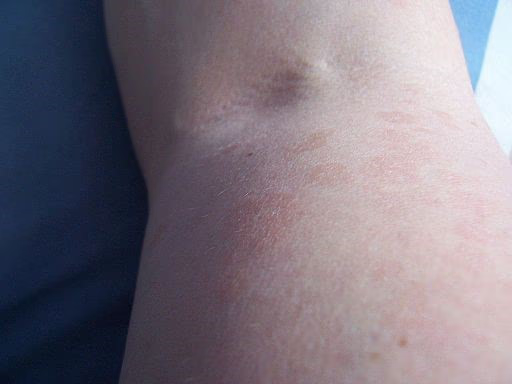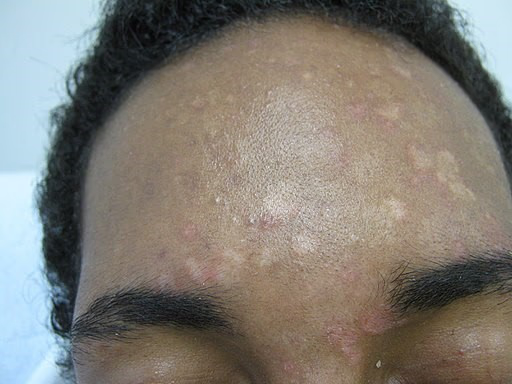Pityriasis versicolor
Tinea versicolor
Peer reviewed by Dr Laurence KnottLast updated by Dr Colin Tidy, MRCGPLast updated 17 Mar 2021
Meets Patient’s editorial guidelines
Pityriasis versicolor is a fungal skin infection caused by a yeast-like germ that causes a rash to form It is not harmful or passed on through touching (contagious). Treatment can clear the rash. Some people who are prone to this condition need regular treatment to prevent the rash from coming back (recurring).
In this article:
Continue reading below
What is pityriasis versicolor?
Small numbers of the malassezia germs that causes pityriasis versicolor commonly live on the skin and do no harm. However, some people are prone to this germ multiplying and spreading on their skin more than usual, which then leads to a rash developing. Often the germ multiplies and causes the rash for no apparent reason. In some cases, hot, sunny or humid weather seems to trigger the germ to multiply on the skin. In people who sweat more it may be more likely to occur.
Pityriasis versicolor is a common fungal condition. It is more common in people in their teens and 20s. It is sometimes called tinea versicolor.
Patient picks for Skin infections
Pityriasis versicolor symptoms
The rash
Pityriasis versicolor close-up

By Richardkiwi at nl.wikipedia (Own work), Public domain, via Wikimedia Commons
This usually starts as small pale patches. Sometimes the rash is darker than the skin in fair-skinned people, and in this case it looks like brown marks. At first these usually appear on your back, chest, neck or upper arms.
The rash sometimes spreads to your tummy (abdomen) and thighs. Occasionally it may affect your face. More patches may appear and patches next to each other may join together. The affected skin may become slightly scaly.
Pityriasis versicolor on the forehead

By Grook Da Oger (Own work) CC BY-SA 3.0, via Wikimedia Commons
The rash is usually pale and is barely noticeable if you are fair-skinned. You may not notice it until after you sunbathe. Affected areas do not tan and therefore the rash becomes more obvious on tanned skin. The pale patches are more obvious if you have dark skin.
There are usually no other symptoms. Sometimes it is slightly itchy.
Continue reading below
Is pityriasis versicolor serious?
No. If you wanted an even suntan then this rash is a nuisance, as pale patches on tanned skin may look unsightly.
Is pityriasis versicolor contagious?
No - it is not possible to catch this condition from another person. The type of yeast that causes the rash is commonly found on the skin and usually does no harm. For reasons that are not clear, it seems that the germ grows out of control more easily with certain people, and causes a rash.
Continue reading below
Pityriasis versicolor treatment
The type of treatment varies between cases and may depend on the location of the rash and also if you have had this condition before. The following are treatment options:
Ketoconazole shampoo (Nizoral®)
Ketoconazole shampoo (Nizoral®): is commonly advised. You can buy this at pharmacies and it is also available on prescription. Ketoconazole kills the germ that causes this rash. Apply the shampoo directly to affected areas and then wash off after three to five minutes. Repeat every day for five days.
Selenium sulfide shampoo
This is an alternative treatment. It is not strictly licensed for the treatment of this rash; however, it works. You can buy it from pharmacies or it is also available on prescription. Apply the shampoo to the affected areas and leave to dry for ten minutes and then rinse off. This should be repeated daily for a week. Diluting it (half water and half shampoo) may prevent it irritating your skin. This should not be used if you are pregnant.
Antifungal creams
These may be used if only a very small area of skin is affected. Clotrimazole (Canesten®) cream is one example. It should be applied twice a day for two or three weeks.
Antifungal tablets
Antifungal tablets may be prescribed if the rash is over a large area of your skin, or is not cleared by the above treatments. The ones used are usually itraconazole or fluconazole.
Antifungal treatment may need to be repeated if this rash comes back (recurs) and becomes scaly again.
If you are prone to develop recurrent episodes in the sun then it may be advisable to use ketoconazole shampoo once a day for three days prior to going on holiday to the sun. This will help to reduce the risk of it occurring when you are away.
Note: after treatment, skin colour usually takes 2-3 months to return to normal. It sometimes takes even longer. As long as the rash is not scaly, this does not mean the treatment has not worked.
How to prevent pityriasis versicolor
Some people seem prone to this yeast-like germ multiplying on their skin and the rash may come back (recur) after treatment. One option is to apply one of the above shampoos to your skin every 2-4 weeks. This may keep the germ away, or prevent the numbers building up, which will prevent the rash from recurring. Alternatively, if you have frequent recurrences then you may be advised to take antifungal tablets for one day each month as a preventative measure.
Further reading and references
- Pityriasis Versicolor; DermIS (Dermatology Information System)
- Pityriasis versicolor; DermNet NZ
- Pityriasis versicolor; NICE CKS, April 2020 (UK access only)
- Gupta AK, Foley KA; Antifungal Treatment for Pityriasis Versicolor. J Fungi (Basel). 2015 Mar 12;1(1):13-29. doi: 10.3390/jof1010013.
Article History
The information on this page is written and peer reviewed by qualified clinicians.
Next review due: 16 Mar 2026
17 Mar 2021 | Latest version

Feeling unwell?
Assess your symptoms online for free
